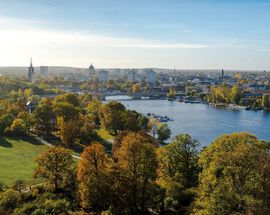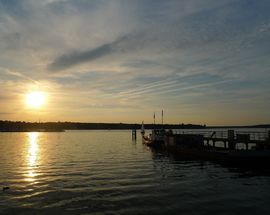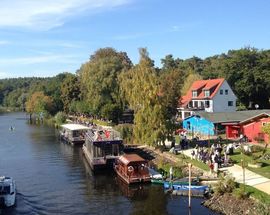Berlin is enormous, with more to offer the visitor than just about every other city in Europe. Sometimes however - especially in the heat of high summer - the big city atmosphere can get to be a little too much, meaning that many people take to the road on day trips. Others choose to take to the water. In the first of a regular series, we have put together a short list of things to do in and around the island of Wannsee and the elegant town of Potsdam, southwest of Berlin: long amongst the most popular summer retreats for Berliners.
Wannsee
The vast majority of Wannsee is covered by the Grunewald forest: primarily conifers but you will see birch trees too. Surrounded by lakes, sparsely populated Wannsee was long ago spotted as the perfect place for the wealthy to build summer houses and villas. One of Germany’s oldest yacht clubs is based here, while there is an attractive golf course too. Artists too have for centuries found the required tranquility and inspiration here.
Today Wannsee attracts a cosmopolitan crowd as well as increasing numbers of foreign visitors, some of whom are drawn by the infamous Wannsee Conference, which took place in the Wannsee Villa in January 1942. Since 1992 the villa has been a memorial to the victims of the Holocaust as well as an outstanding museum comprising a large permanent exhibition clearly and precisely explaining the Holocaust and the villa’s role in it, as well as smaller temporary exhibitions.
Walking paths crisscross the island, and there are a number of well-marked routes, a couple of which can be picked up from Wannsee S-Bahn station. For those of you looking for aquatic pursuits, the Söhnelwerft centre offers just that. From the Söhnel boatyards at the Teltowkanal, canoe trips cross the Griebnitzsee to the Glienicker bridge and the Meierei. Crossing the deep lakes you can paddle as far as Potsdam. It is the perfect way to see the elegant villas of the area. Söhnelwerft offers boats for both beginners and advanced canoers, and there are a number of routes to follow. For the less active there are hop-on, hop-off boat tours which circumnavigate Wannsee. Another heads down through the Potsdam harbour while the longest takes you as far as the Schlanitzsee, returning via the Sacrow-Paretzer Canal.
Söhnelwerft is the perfect place for lunch: its restaurant is superb and set in a gorgeous location on the water’s edge. There is also a cafe, a beer garden and sun terrace. A popular event venue, Söhnelwerft can host parties on a variety of boats, as well as in the boathouse. You can get to Söhnelwerft by S-Bahn (S7) to Griebnitzsee, or RegionalBahn (RB21, RB22) to Potsdam Griebnitzsee. Many people also choose to bike here: you can take your bike on the S-Bahn and the cycle from the station. Wannsee itself is perfect for biking. You can also of course get here by boat: the Stern und Kreis Seven Lakes Boat Tour stops here (get off at Kohlhasenbrück).
Potsdam
Frederick II the Great loved Potsdam. The ruler of Berlin and all Prussia from 1740 to 1786 built his favourite abode, Sanssouci, here. 'Without a worry' was the French name of his palace, though thanks to considerable care taken by its architect Georg Wenzeslaus von Knobelsdorff, craftsmen, and artisans, it is hailed as the Versailles of Germany. Sanssouci was intended as a summer residence, and though Frederick stretched out the seasons he spent here. The 18th century rococo-style schloss has a gorgeous approach up a flight of vineyard terraces. Frederick loved his little 'Prussian Arcadia' and was buried on here at his own request. The original palace rooms and guest apartments host works by Rubens, Van Dyck and Caravaggio. The palace sits within the 290 hectares of Park Sanssouci, which holds a botanical garden, an Orangerie, Roman baths, the Chinese House, the Neues Palais, and Karl Friedrich Schinkel's Schloss Charlottenhof, whose interior is perhaps the best preserved example of Schinkel's work. Each sight has its own separate admission charge and changing exhibits. The hilltop Belvedere auf dem Pfingstberg is a romantic folly lookout tower completed in 1863. On busy days arrive early to secure tour tickets, or join the tourism office's Sanssouci tour which includes the palace even when day tickets are sold out.
A pleasant half an hour walk across town (or bus No. 603) is the Schloss Cecilienhof, where twentieth-century history was made in August 1945 as Stalin, Truman and Attlee decided the future of postwar Germany. The half-timber mansion between two lakes in the Neuer Garten was finished in 1917.
Besides the palaces and parks, the compact town’s centre, half faded and half restored, makes for a pleasant stroll. The Kolonie Alexandrowka is in a park along Puschkinallee, south of the rise to the Belvedere. Quaintly enough, the log cabins here were built in 1826 for a 12-member Russian choir who had helped the Prussians fight Napoleon. Most of the boys got homesick and eventually left. The redbrick Holländisches Viertel (Dutch quarter) is another failed settlement, but a great place to get a meal and browse in some shops. Friedrich Wilhelm I built the small district in the 1730s to attract Dutch craftsmen.
And do not leave Potsdam without visiting the Barberini Museum in the Barberini Palace. Opened in January and absolutely not to be confused with the institution of the same name in Rome, this new art museum is the creation of the software magnate Hasso Plattner, whose wealth Forbes puts at $9.8 billion. It is collection which forms the core of what’s on show. Current exhibition: Picasso, The Late Work. From the collection of Jacqueline Picasso.
Barberini Museum
Do not leave Potsdam (or even Berlin) without visiting the Barberini Museum in the Barberini Palace. Opened in January and absolutely not to be confused with the institution of the same name in Rome, this new art museum is the creation of the software magnate Hasso Plattner, whose wealth Forbes puts at $9.8 billion. It is collection which forms the core of what’s on show. The current exhibition is: Picasso, The Late Work. From the collection of Jacqueline Picasso.
Filmpark Babelsberg
More than 3,000 films have been shot at the famous Babelsberg UFA/DEFA studios, including Fritz Lang's legendary Metropolis (1927). The themepark surrounding the studios is great for children and adults. Though some the featured films and TV characters may be unfamiliar to foreigners, there's enough action to keep you amused, including stunt, animal and pirate shows, studio tours and a thrilling behind the scenes insights into special effects through the years including some amazing stunts. There's an English-language audio-guide too. From Babelsberg S-Bahn station take bus N°601 or 690; alternatively take the RE train to Medienstadt Babelsberg station and walk.Schloss Sanssouci
The 18th century rococo-style Schloss Sanssouci (Without Worries) has a gorgeous approach up a flight of vineyard terraces. Frederick the Great loved his little 'Prussian Arcadia' and was buried on here at his own request. The original palace rooms and guest apartments host works by Rubens, Van Dyck and Caravaggio. The palace sits within the 290 hectares of Park Sanssouci, which holds a botanical garden, an Orangerie, Roman baths, the Chinese House, the Neues Palais, and Karl Friedrich Schinkel's Schloss Charlottenhof, whose interior is perhaps the best preserved example of Schinkel's work. Each sight has its own separate admission charge and changing exhibits. The hilltop Belvedere auf dem Pfingstberg is a romantic folly lookout tower completed in 1863. On busy days arrive early to secure tour tickets, or join the tourism office's Sanssouci tour which includes the palace even when day tickets are sold out. From Potsdam Hauptbahnhof station take bus N°612, 614 or 695.
House of the Wannsee Conference
Wannsee attracts a cosmopolitan crowd as well as increasing numbers of foreign visitors, some of whom are drawn by the infamous Wannsee Conference, which took place in the Wannsee Villa in January 1942. Since 1992 the villa has been a memorial to the victims of the Holocaust as well as an outstanding museum comprising a large permanent exhibition clearly and precisely explaining the Holocaust and the villa’s role in it, as well as smaller temporary exhibitions.Söhnel Werft








Comments